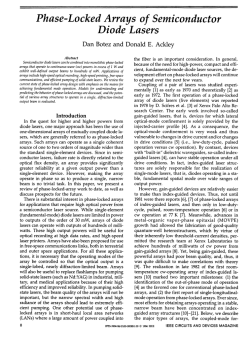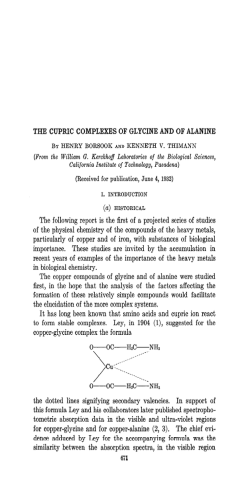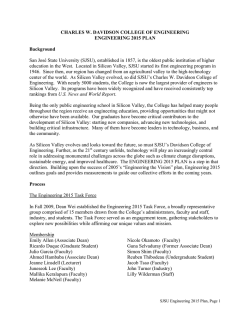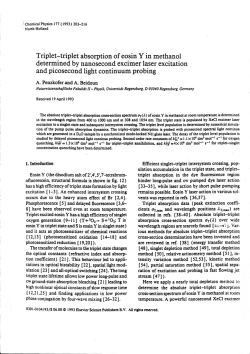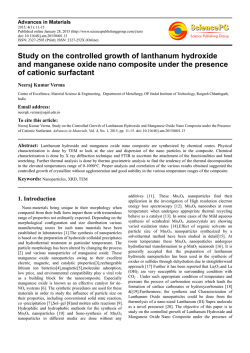
Evidencing of germanium nanopyramid arrays for
Nano Research Nano Res DOI 10.1007/s12274-015-0731-0 Evidencing of germanium nanopyramid arrays for near100% absorption in visible regime Qi Han1, Yongqi Fu1(), Lei Jin1, Jingjing Zhao3, Zongwei Xu2, Fengzhou Fang2, Jingsong Gao3, Weixing Yu4 Nano Res., Just Accepted Manuscript • DOI 10.1007/s12274-015-0731-0 http://www.thenanoresearch.com on January 28, 2015 © Tsinghua University Press 2015 Just Accepted This is a “Just Accepted” manuscript, which has been examined by the peer-review process and has been accepted for publication. A “Just Accepted” manuscript is published online shortly after its acceptance, which is prior to technical editing and formatting and author proofing. Tsinghua University Press (TUP) provides “Just Accepted” as an optional and free service which allows authors to make their results available to the research community as soon as possible after acceptance. After a manuscript has been technically edited and formatted, it will be removed from the “Just Accepted” Web site and published as an ASAP article. Please note that technical editing may introduce minor changes to the manuscript text and/or graphics which may affect the content, and all legal disclaimers that apply to the journal pertain. In no event shall TUP be held responsible for errors or consequences arising from the use of any information contained in these “Just Accepted” manuscripts. To cite this manuscript please use its Digital Object Identifier (DOI®), which is identical for all formats of publication. 1 Evidencing of germanium nanopyramid arrays for near-100% absorption in visible regime Qi Han1, Yongqi Fu1* , Lei Jin1 ,Jingjing Zhao3 , Zongwei Xu2, 1 Fengzhou Fang2, Jingsong Gao3, Weixing Yu4 University of Electronic Science and Technology of China, China 2 Tianjin University, China 3 Chinese Academy of Sciences, China 4 Shenzhen University, China In the visible regime, the experimentally measured absorption of germanium nanopyramid arrays can even reach to the level of as high as 100%. Nano Research DOI (automatically inserted by the publisher) Research Article Evidencing of germanium nanopyramid arrays for near100% absorption in visible regime Qi Han1, Yongqi Fu1(), Lei Jin1, Jingjing Zhao3, Zongwei Xu2, Fengzhou Fang2, Jingsong Gao3, Weixing Yu4 Received: day month year ABSTRACT Revised: day month year Solar energy is regarded as one of the most plentiful harvest sources of Accepted: day month year renewable energy. An extraordinary light harvesting property of a germanium (automatically inserted by the publisher) © Tsinghua University Press periodic nanopyramid array is reported in this letter. Both of our theoretical and experimental results demonstrate that the nanopyramid array can gain the perfect broadband absorption in the wavelength from 500 nm to 800 nm. and Springer-Verlag Berlin Especially in the visible regime, the experimentally measured absorption can Heidelberg 2014 even reach to the level of as high as 100%. Further analyses reveal that intrinsic antireflection effect and slowlight waveguide mode play an important role in KEYWORDS the ultra-high absorption. It is helpful for research and development of nanopyramid array, absorption coefficient, antireflection coatings, slowlight mode photovoltaic devices. 1 Introduction Sustainable energy is a challenging problem for Address correspondence to Yongqi Fu, [email protected] human bein gs in current ce ntury. Rec ently, tremendous progress has been made for the purpose of developing photovoltaics that can be potentially 2 Nano Res. mass deployed since photovoltaic cells can serve as harness a large fraction of the incident solar a virtually unlimited clean source of energy by photons. In this regard, simulation studies have converting sunlight into electrical power[1-4]. In previously shown that three-dimensional (3D) cell these progresses, optical absorption has been paid structures attention as an effective and powerful way to boost nanopillar arrays [11-13],nanocone arrays [14-16], energy conversion efficiencies. The ability to nanohole deposit sunlight is of profound interest for [21,22] ,and other perfect absorbers[23-26] have high-performance proven to possess unique optical characteristics for solar cell applications. such as arrays nanowire [17-20], arrays nanodisk [7-10], arrays Conventional silicon thin film-based photovoltaic light absorbing and harvesting. cells are inefficient even though nanostructures in nanopyramid arrays silicon photovoltaic cells is of particular importance coefficient which is caused from both an intrinsic as these currently make up over 80% of the antireflection effect [15] and stimulating slowlight photovoltaic market in the world[5]. Advantage of waveguide mode of weakly coupled resonances. the silicon-based photovoltaic cells with short [10,27] In this letter, evidences from both theoretical collection length for excited carriers results in experimental significant collection germanium nanopyramid arrays surely retain the efficiency. Silicon, however absorbs poorly over the ability to reach perfect absorption in visible regime. improvement in carrier peak of the solar spectrum, requiring the use of over 100 μm thick Si wafers for sufficient absorption. 2 study can are Germanium improve absorption provided that the Experimental Germanium belongs to indirect-gap materials as A silica glass substrate supported germanium same as silicon. In contrast, germanium has lower thin film of 1 m in thickness was coated using band gap. The gap results in a phenomenon that the electron beam evaporation technique. Figure 1 (a) photons with lower energy can excite electrons shows the schematic migration from valence band to conduction band. nanopyramid And electron-hole pairs produce accordingly. It experiment was carried out using our focused ion means the germanium thin film-based structures beam (FIB) machine (FEI NOVA200 Nanolab) which can increase optical absorption coefficient in is equipped with a liquid gallium ion source. This broader band than that of silicon material. FIB machine is integrated with a scanning electron Meanwhile, photons microscope (SEM), and a gas-assistant etching (GAE) excitation, more heat can be produced, and higher functions. This machine employs a focused Ga + ion temperature also improves efficiency of generation beam milling under energy of 30 keV, a probe and separation of electron-hole pairs as well as current of 4 pA~19.7 nA, and beam limiting photoelectric conversion efficiency in germanium aperture size of 25 m~350 m. For the smallest structures in comparison to the silicon materials. beam currents, the beam was focused down to 5 nm In material-based in diameter at full width and half maximum structures can lift the internal quantum efficiency (FWHM). Assisting by a computer program, the and short circuit current to increase the efficiency of milling process is carried out by means of varying photovoltaic cells. the ion dose for different relief depths. The defined other with words, the same germanium energy illustration structure. The of periodic nanofabrication Whereas thin film photovoltaic cells offer a viable area for the FIB milling using bitmap function[28, pathway to reduce fabrication costs and material 29] is 9 9 m2. During the milling process, the usage[6], their energy conversion efficiencies can beam current and ion dose of 20 pA and 0.25 still be improved significantly by enabling them to nC/m2 | www.editorialmanager.com/nare/default.asp were adopted respectively. Working 3 Nano Res. distance from sample surface to facet of ion column and just joining each other, and then the 3D is 20 mm. Electron mode of the FIB milling was pyramid array is formed finally. selected for the germanium thin film. Charging effect originating from the germanium is slightly 3 Results and discussion during scanning and can be ignored here. Unlike Figures 1 (c), (d) and (e) exhibit scanning electron conventional two-dimensional (2D) structures, one microscope (SEM) images of the nanopyramid step FIB milling of the three-dimensional (3D) arrays. For convenient characterization, total eight patterns nanopyramid arrays is quite challenge. Firstly, precise thin were fabricated on film, and the side the calibration is required to ensure the accurate depth germanium length milling. Then a designed 2D pattern (see Fig. 1b) of each square nanopyramid array is determined was called into the defined milling area. Feature to be 20 μm. These germanium nanopyramid arrays size of the pattern was defined on the basis of the had a uniform height of about 500 nm and bottom rate of self-extension effect which is generated by length size of about 200 nm. All germanium redeposition effect of the ion beam bombardment nanopyramid arrays are closely packed and display while designing the pattern. Initially, a concave in short-range order. V-shape of the reverse pyramid structure with a few For design of the nanopyramid structures, we nanometer depth is produced. After 15 min. need to take into account the wave effects by means continuous are of solving Maxwell’s equations for the full wave over-milled so as to enable the reverse pyramid vector. A finite-difference and time-domain (FDTD) milling, the squared areas structure originated from the square area extending (a) (b) (c) (d) (e) Figure 1 (a) Schematic diagram of the nanopyramid arrays absorber; (b) binary bitmap pattern designed for fabrication of the nanopyramide array; (c) overall SEM images of total eight nanopyramid arrays; (d) SEM image of a germanium nanopyramide array; (e) zoom-in SEM images of the germanium nanopyraim arrays with measured sizes in vertical and horizontal. www.theNanoResearch.com∣www.Springer.com/journal/12274 | Nano Research 4 Nano Res. algorithm has been proven to be effective for numerically calculating such periodic structures. In our analyses, we use FDTD solution 8.5 (from Lumerical Solution Inc.) and set a fine grid dimension of 5 nm5 nm5 nm, which is less than 1/100 of the shortest wavelength in the whole computation domain so as to ensure convergence of the calculation process. The wavelength is ranging from 500 nm to 800 nm. Figure 2 (a) shows the experimental setup for spectroscopy. (b) The absorption spectrum of the nanopyramid arrays and thin film are shown in Fig. 2 (b) and (c).In order to simulate reality of situation, we put eight nanopyramid arrays in a field of view. Th e abs orption s pectrum is the average of eight nanopyramid arrays. We observed a substantial absorption enhancement over the entire usable solar spectrum in nanopyramid arrays structure. In comparison to the experimental results, corresponding numerical calculation results show (c) that the absorption coefficient declines slightly from 1 to 0.983 in the nanopyramid arrays, but the absorption coefficient still maintains at the level of Figure 2 (a) Experimental setup of the spectrometry system, an perfect absorption which is higher than the optical fiber-based spectrometer from Ocean Optics is previous reports.[10, 15, 24, 27] The absorption employed; (b) measured and simulated results of absorption coefficient is larger than the other reported coefficient on samples with nanopyramid arrays; (c) measured nanostructures in the wavelength from 400 nm to and simulated results of absorption coefficient on samples with 800 nm. Absorption coefficient in calculation is flat thin film. smaller than that of experiments. This can be attributed to SiO2 impurities on the sample play a dominant role in increasing absorption coefficient as an antireflection coating. The Considering the high refractive index contrast ultra-high between germanium and air, a large portion of absorption may be explained in detail in physical incident light is reflected back from the surface of point of view as follows. the germanium thin-film and thus cannot be used to generate current in future solar cell. Currently, quarter-wavelength transparent thin films become the industrial standard for antireflection coatings for the thin film solar cells. However, this quarter-wavelength antireflection coatings is typically designed to suppress reflection at a specific wavelength.[30, 31] In the nanopyramid (a) arrays, the electromagnetic field can be coupled | www.editorialmanager.com/nare/default.asp 5 Nano Res. efficiently into the pyramids cavity at resonances, and resulting in a significant light-trapping ability boost. For the nanopyramid arrays with small filling factor, most of the incident light cannot be coupled into the nanopyramid arrays, but is absorbed in a single path through the array. In contrast, the nanopyramid arrays with large filling factor provide efficient supported modes. Hence the (a) (b) (c) (d) absorption is greatly increased when these modes are well coupled and concentrated in the array.[32] The contribution for light absorption enhancement from the structured area as shown in Fig. 2(b), in comparison to the absorption of the flat thin film without any structures shown in Fig. 2(c), originates from lighting trapping and antireflection effect. The nanopyramid arrays suppress reflection because the pyramid geometry provides an Figure 3 Electromagnetic field distribution at y=0 plane for averaged, graded index from air to germanium as different wavelengths. (a) λ=500 nm; (b) λ=600 nm; (c) λ=700 the side length increases from zero to maximum nm; and (d) λ=800 nm. value at the planar film surface. The reflection suppression is broadband since the index-matching which are close to the interface between is largely independent to wavelength. On the other nanopyramid and air regions. The vortexes locate hand, the nanostructures can be regarded as a exactly at the places where the electromagnetic field special type of metamaterials. To achieve effective highly concentrates. These are typical features in antireflection, the periodicity of the array has size slowlight waveguides with the slowlight defined as ranging in the subwavelength regime based on the the propagation of light at a quite low group incoming light to see an effective averaged velocity in comparison to the light speed in index.[15] In addition, a high aspect ratio of the vacuum.[33-35] For example, in Ref. 33 the authors arrays is preferred so as to provide a smooth index demonstrated that the designed air/dielectric/metal transition from air to germanium. waveguide could support such kind of vortex mode Meanwhile, such nanopyramid arrays -bas ed propagating very slowly along the slab and even ultra-short vertical waveguides support slowlight being trapped at a critical core thickness. Later, a mode at different wavelengths so that the incident nanopyramid/air/nanopyramid light at different wavelengths is captured at the waveguide has also been presented to slow down position of different tooth widths (lateral size of the the electromagnetic single pyramid). As can be seen in Fig. 3, light is complete standstill at certain regions of the air core m a i n l y abs o r b e d o n t h e t o p o r e dge of waveguide. Light with different wavelengths as nanopyramid. Most of the incident energy firstly different photons energy has different penetration propagates downwardly along z-direction in the air depths. In short wavelength, most of light is ga p r e gi on wi t h o ut p e n et rat i n g in t o t h e absorbed on the top of nanopyramid arrays. With nanopyramid arrays and then whirls into the increasing of the wavelength, focusing regime of the nanopyramid region. The whirling forms vortexes electromagnetic field is shifting to the bottom of the slowlight propagating waves to a www.theNanoResearch.com∣www.Springer.com/journal/12274 | Nano Research 6 Nano Res. nanopyramid. This means, light with different the working mode of confocal imaging in which the wavelengths is absorbed in the nanopyramid sample is stationary and only stage scans in arrays. horizontal plane. This is a finely focused far-field In order to intuitively observe the absorption imaging with resolution within diffraction limit. effect occurred on the areas of structured and Fiber tip is not necessary in this imaging mode. non-structured, we utilized an apertured near-field Intensity distributions can be derived from the scanning optical microscope (a-NSOM, modeled confocal images, as shown in Fig. 4. As can be seen Multiview 2000TS from Nanonics Inc.) to gain the from Figs. 4 (a) and (b), optical intensity in both optical intensity distributions. Firstly, we selected (a) (b) (c) (d) Figure 4 Intensity distributions for both structured and non-structured areas, (a) nanopyramid arrays scan area is 5 m5 m; (b) flat thin film area without structure, imaging area is 5 m5 m; (c) hybrid section (bright part indicates flat thin film only), imaging area is 20 m20 m. (d) NSOM image of the hybrid section. The color bars indicate relative light intensity. The value approaching 0 means near-100% absorption from the area with the pyramid arrays. | www.editorialmanager.com/nare/default.asp nanopyramid arrays and flat thin film regime are energy nowadays, it is reasonable to believe that the apparently distinct nevertheless imaging resolution proposed is low compared to feature size of the structures. It applications in those light harvesting related areas. can be seen from the color bar that intensity in the nanopyramid arrays is about zero, and about 0.06 in flat thin film while the maximum intensity is 0.16. This result is well matched with absorption coefficient above. Figure 4 (c) exhibits intensity distribution in a section of the sample which absorber will find its potential References [1]Atwater,Harry,A.; Polman,albert. P lasmonics for improved photovoltaic devices. Nat. Mater. 2010,9, 205-214. [2]Catchpole, K. R.; Polman, A. Plasmonic solar cells. Opt. Express. 2008, 16,21793-21800. involves both structured and non-structured areas [3] Zeng, B.; Gan, Q.; Kafafi, Zakya H.; Bartoli, Filbert J. for the purpose of comparing clearly. It can be seen Polymeric photovoltaics with various metallic plasmonic that intensity in the regimes of nanopyramid arrays nanostructures J. Appl. Phys. 2013, 113, 063109. and flat thin film are apparently different with color [4]Gan,Q.;Bartoli,FilbertJ.;Kafafi,ZakyaH.Plasmonic-Enhanced scale variation from 0 to 0.20. Similarly, we also Organic Photovoltaics: Breakingthe 10% Efficiency Barrier. gave the corresponding near-field imaging of the Adv. Mater. 2013, 25, 2385-2396. hybrid section, as shown in Fig. 4 (d). A portion of [5] Gunawan ,O.; Wang,K. ; Fallahazad,B.; Zhang,Y.; Tutuc,E.; flat thin film regime adjacent to nanopyramid and Guha, S. High performance wire-array silicon solar arrays regime can partially absorb light cells. Prog. Photovolt. Res. Appl. 2010,10, 1002. since a nanopyramid can actually absorb not only the portion of an incident wave directly but also the surrounding wave. It is well-known that a small single particle can behave having a absorption cross section than results indirectly nanopyramide arrays [7] Cao, L.; Fan,P.; Vasudev, Alok P. ; White, Justin S.; Yu, Z.; Cai, W.; Schuller,Jon A.; Fan,S.; Brongersma, M. L.; corresponding Semiconductor Nanowire Optical Antenna Solar Absorbers. prove that Nano Lett.2010,10,439-445 the [8] Guo, H.; Wen, L.; Li, X.; Zhao, Z.; Wang ,Y.; Analysis of can surely realize the optical absorption in GaAs nanowire arrays. Nanoscale ultra-high absorption in visible regime. 4 London, 2008. larger geometrical cross section.[11, 32] This confocal imaging [6] Nelson, J.; Physics of Solar Cell; Imperial College Press: Conclusions In summary, a germanium nanopyramid array is proposed and fabricated. Both theoretical and Research Letters,2011, 6,617 [9] Cao, L.; White, J. S.; Park,J.-S.; Schuller,J. A.; Clemens ,B. M.; Brongersma, M. L. Engineering light absorption in semiconductor nanowire devices. Nat. Mater. 2009, 8, 643-647. experimental results verified that it is capable of [10] Hu, L.; Chen, G.Analysis of Optical Absorption in Silicon achieving a perfect absorption in the wavelength Nanowire Arrays for Photovoltaic Applications. Nano Lett. from 500 nm to 800 nm, even as high as 100% in characterization. We analyzed the phenomena in 2007,7,3249-3252 [11] Tsai, S. J.; Ballarotto, M.; Romero, D. B.; Herman, W. N.; physical mechanism point of view by means of Kan,H.-C.;Phaneuf, R. J. Effect of gold nanopillar arrays on regarding germanium as a bulk material according the absorption spectrum of a bulk heterojunction organic to the corresponding band gap theory. The high solar cell.Opt. Express. 2010,18,A528-A535. absorption coefficient of the nanopyramid arrays [12] Fan ,Z.; Kapadia, R.; Leu, P. W.; Zhang, X.; Chueh; was investigated with the efforts of light trapping, Y.-Lun.; Takei, K.; Yu, K.; Jamshidi, A.; Rathore, A. A.; antireflection coatings and slowlight mode. With Ruebusch, D. J.; Wu,M.; Javey Ali. Ordered Arrays of the vast demand of the sustainable and green Dual-Diameter Nanopillars for Maximized Optical Nano Res. Absorption . Nano Lett. 2010, 10, 3823–3827 Kafafi, Zakya H. Super absorption of ultra-thin organic [13]Fan,Z.; Razavi, H.; Do, J.-w.; Moriwaki, A.; Ergen, O.; Chueh,Y.-L.;Leu, P.W.; Ho,J. C.; Takahashi, T.; Reichertz, L. photovoltaic films. Opt. Comm. 2014,314, 48-56 ; [25] Ji, D.;Song, H.; Zeng, X.; Hu ,H.; Liu, K.; Zhang, N.; Gan, A.; Neale,S.; Yu,K.; Wu,M.; Ager J.W.; Javey, A. Q.Broadband absorption engineering of Three-dimensional metafilm patterns.Sci. Rep. 2014,4, 4498 nanopillar-array photovoltaics on low-cost and flexible substrates. Nat. Mater. 2009,8, 648-653 [26]Zeng,B.;Kafafi,Zakya H.;Bartoli ,Filbert J.; hyperbolic Transparent electrodes based on two dimensional Ag nanogrids and [14] Wang,B.; Leu,P. W. Enhanced absorption in silicon nanocone arrays for photovoltaics. Nanotechnology.2012, 23, 194003-194003 double one-dimensional Ag nanogratings for organic Photovoltaics. J. Photon. Energy .2015,5, 057005 [27] Cui,Y.; Fung, K.; Xu,J.; Ma, H.; Jin,Y.; He ,S.; Fang,X. [15] Wang, K.; Yu, Z.; Liu,V.; Cui, Y.; Fan S.; Absorption Ultrabroadband Light Absorption by a Sawtooth Enhancement in Ultrathin Crystalline Silicon Solar Cells Anisotropic Metamaterial Slab. Nano Lett. 2012,12,1443- with Antireflection and Light-Trapping Nanocone Gratings. 1447 Nano Lett. 2012, 12, 1616 −1619 [28] Fu, Y.; Bryan,Ngoi Kok Ann. Data format transferring [16] Zhu,J.; Yu,Z.; Burkhard, G.F.; Hsu,C.-M.; Connor, S.T.; Xu, Y.; Wang, Q.; McGehee ,M.; Fan, S.; Cui ,Y. Optical Absorption Enhancement in Amorphous Silicon Nanowire and Nanocone Arrays. Nano Lett. 2009,9,279-282. [17]Han, S. E.; Chen, G. Optical Absorption Enhancement in Silicon Nanohole Arrays for Solar Photovoltaics. Nano Lett. 2010, 10, 1012–1015. for FIB microfabrication. Int. J. Adv. Manufact. Technol. 2000, 16, 600-602. [29]Fu,Y.; Bryan,Ngoi Kok Ann. Fabrication and characterization of slanted nanopillars arrays J. Vacu. Sci. Technol. B. 2005,23, 984-989. [30] Street, R. A. Hydrogenated Amorphous Silicon; Cambridge University Press: Cambridge, 1991. [18]Yahaya,N. A.; Yamada, N. ; Kotaki ,Y.; Nakayama,T. [31]Shah, A. V.; Schade, H.; Vanecek, M.; Meier, J.; Characterization of light absorption in thin-film silicon with Vallat-Sauvain, E.;Wyrsch, N.; Kroll, U.; Droz, C.; Bailat, J. periodic nanohole arrays. Opt. Express. 2013,21, 5924-5930 Thin-film Silicon Solar Cell Technology. Prog. Photo [19]Zhang, L.-Ch.; Yang, G.; Wang, K.; Fu, M.; Wang ,Y.; Long, H.; Lu, P.; Opt.Comm. 2013,291, 395–399 Voltaics. 2004, 12(2-3), 113–142, . [32] Han, Q. ; Jin, L. ; Fu,Y. ; Yu,W. Polarization and incident [20] Lin,C.; Mart´ınez, L. J.; Povinelli, M. L. Experimental angle insensitive germanium nano-pyramid array for broadband absorption enhancement in silicon nanohole perfect absorption in visible regime. Insciences J.. 2014,4, structures with optimized complex unit cells. Opt. Express. 19-26. 2013, 21 ,A872-A882. [33] He,J.; He,S. Slow propagation of electromagnetic waves in [21]Liu, N.; Mesch, M.; Weiss, T.; Hentschel, M.; Giessen, H. a dielectric slab waveguide with a left-handed material Infrared Perfect Absorber and Its Application As Plasmonic substrate.IEEE Microw and Wireless Compon. Lett. 2005, Sensor .Nano Lett. 2010,10, 2342–2348, 16, 96-98. [22] Zhang, B.; Zhao, Y.; Hao,Q.; Kiraly,B.; Khoo, I.-C.; Chen,S.; Huang, T. J. Polarization-independent dual-band infrared perfect absorber based on a metal-dielectric-metal elliptical nanodisk array.Opt. Express.2011,19, 1522115228 [34]Jiang,T.; Zhao, J.; Feng,Y. Stopping light by an air waveguide with anisotropic metamaterial cladding Opt. Express. 2009,17, 170 −177. [35] Tsakmakidis, K. L.; Boardman, A. D.; Hess,O. ’Trapped rainbow’ storage of light in metamaterials. Nature. 2007, [23] Hao; J.; Wang, J.; Liu,X.; Padilla,W. J.; Zhou, L.; Qiu,M. 450, 397 −401. High performance optical absorber based on a plasmonic metamaterial. Appl. Phys. Lett. 2010.96, 251104 [24]Liu,K.; Zeng B.; Song, H.; Gan, Q,; Bartoli, Filbert J. ; | www.editorialmanager.com/nare/default.asp
© Copyright 2025
